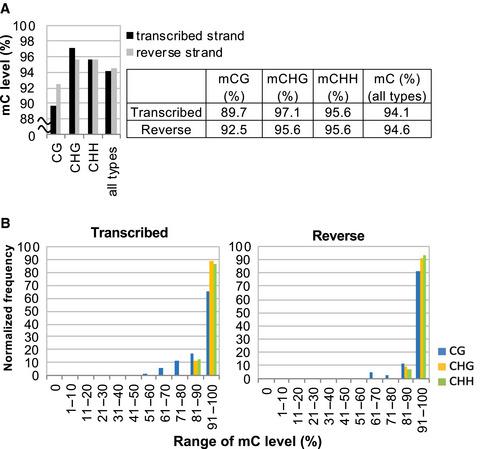当前位置:
X-MOL 学术
›
FEBS Lett.
›
论文详情
Our official English website, www.x-mol.net, welcomes your
feedback! (Note: you will need to create a separate account there.)
The genome of the Cauliflower mosaic virus , a unique plant pararetrovirus, is highly methylated in the nucleus but is transcribed from virions
FEBS Letters ( IF 3.0 ) Pub Date : 2020-06-01 , DOI: 10.1002/1873-3468.13852 Natsuki Omae 1 , Masashi Suzuki 1 , Masashi Ugaki 1
FEBS Letters ( IF 3.0 ) Pub Date : 2020-06-01 , DOI: 10.1002/1873-3468.13852 Natsuki Omae 1 , Masashi Suzuki 1 , Masashi Ugaki 1
Affiliation

|
Cytosine methylation is an important defense against invasive DNAs. Here, cytosine methylation profiles of a plant pararetrovirus, Cauliflower mosaic virus (CaMV), were investigated. Nuclear CaMV DNA is highly methylated throughout the genome including at transcription regulatory regions, but the virion DNA is unmethylated. In vitro CG methylation of the viral 35S promoter reduces transcription from the downstream gene. Although nuclear CaMV DNA is highly methylated, its transcripts are accumulated in the nucleus. The data suggest that a small population of unmethylated viral genomes produced through reverse transcription are constantly delivered back to the nucleus. Small RNA profiles suggest that methylation of the CaMV DNA may be due to de novo methylation through 21‐, 22‐, and 24‐nt small RNAs with adenines at their 5' terminus.
中文翻译:

花椰菜花叶病毒是一种独特的植物副逆转录病毒,其基因组在细胞核中高度甲基化,但由病毒体转录而来
胞嘧啶甲基化是抵御侵入性 DNA 的重要防御措施。在这里,研究了植物副逆转录病毒花椰菜花叶病毒 (CaMV) 的胞嘧啶甲基化谱。核 CaMV DNA 在整个基因组中高度甲基化,包括在转录调控区,但病毒体 DNA 未甲基化。病毒 35S 启动子的体外 CG 甲基化减少了下游基因的转录。尽管核 CaMV DNA 高度甲基化,但其转录物在细胞核中积累。数据表明,通过逆转录产生的一小部分未甲基化的病毒基因组不断地被送回细胞核。小 RNA 谱表明 CaMV DNA 的甲基化可能是由于 21-、22-和 24-nt 小 RNA 的 5' 末端带有腺嘌呤的从头甲基化所致。
更新日期:2020-06-01
中文翻译:

花椰菜花叶病毒是一种独特的植物副逆转录病毒,其基因组在细胞核中高度甲基化,但由病毒体转录而来
胞嘧啶甲基化是抵御侵入性 DNA 的重要防御措施。在这里,研究了植物副逆转录病毒花椰菜花叶病毒 (CaMV) 的胞嘧啶甲基化谱。核 CaMV DNA 在整个基因组中高度甲基化,包括在转录调控区,但病毒体 DNA 未甲基化。病毒 35S 启动子的体外 CG 甲基化减少了下游基因的转录。尽管核 CaMV DNA 高度甲基化,但其转录物在细胞核中积累。数据表明,通过逆转录产生的一小部分未甲基化的病毒基因组不断地被送回细胞核。小 RNA 谱表明 CaMV DNA 的甲基化可能是由于 21-、22-和 24-nt 小 RNA 的 5' 末端带有腺嘌呤的从头甲基化所致。











































 京公网安备 11010802027423号
京公网安备 11010802027423号